
Welcome to the fun world of beachcombing on the Oregon Coast, where the waves serenade and the sands hold hidden treasures! Beachcombing is the activity of searching the shore for natural and man-made objects, and we're here to guide you through the exciting things you can find (and maybe take home) on your coastal adventure!
Beachcombing along the Oregon Coast is a popular pastime for those who love spending time at the beach, searching for the ocean's revealed treasures. You can find an array of items on Oregon's beaches, including sea glass, driftwood, Japanese glass floats, shells (like the ever-popular sand dollars), and even fossilized marine life.
Since Oregon’s beaches are open to the public year-round, beachcombers are generally allowed to keep their finds—with some exceptions. Be sure to check the Rules and Regulations before heading out.
The best part? These treasures are free! (Well, aside from the cost of gas and the calories burned collecting them.) Here are some unique finds to keep an eye out for.

Collecting Rocks and Minerals - Oregon Coast Rockhounding
Oregon's ocean beaches are famous for their beach-tumbled agates, jasper, and petrified wood, making them a hotspot for rockhounds.
The best time to hunt for these gemstones is during the winter months, from November to March (and sometimes April). Summer sands usually cover most agate deposits, but winter storms strip away the top layers, revealing the treasures beneath. Any beach with gravel patches is likely to hide agatized gems.
No special technique or equipment is needed—though a gem scoop and geology pick can be handy. All you really need is a sense of adventure and some warm, waterproof clothing!
Numerous coastal locations offer opportunities to hunt for agate and jasper, but certain beaches are truly a haven for rock collectors.
Short Beach and Tunnel Beach, located between Cape Meares and Maxwell Point at Oceanside, are the best on the northern Oregon Coast.
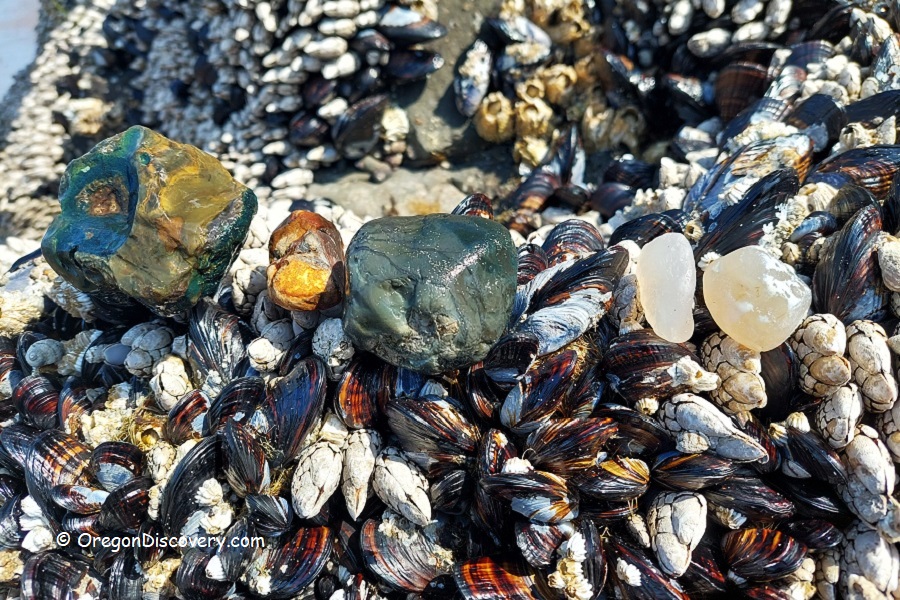
On the Central Oregon Coast, some of the top rock-collecting beaches are found south of Yachats, including Neptune Beach, Strawberry Hill Wayside, Bob Creek Beach, Stonefield Beach, Big Creek Beach, and Carl Washburne State Park.
The southern Oregon Coast, particularly near Bandon, Gold Beach, Port Orford, and Brookings, offers fantastic opportunities to discover high-quality gemstones. As you approach the California border, your chances of finding rare nephrite jade increase.
The southern coastline is especially productive for agate hunting, particularly where coastal rivers—such as the Rogue River, Sixes River, Hunter Creek, Pistol River, or Chetco River—meet the ocean. Beaches like Garrison Beach, Bailey Beach, South Beach, Arriya's Beach at the mouth of Pistol River, and McVay Rock Park are rich in rock-collecting potential year-round.
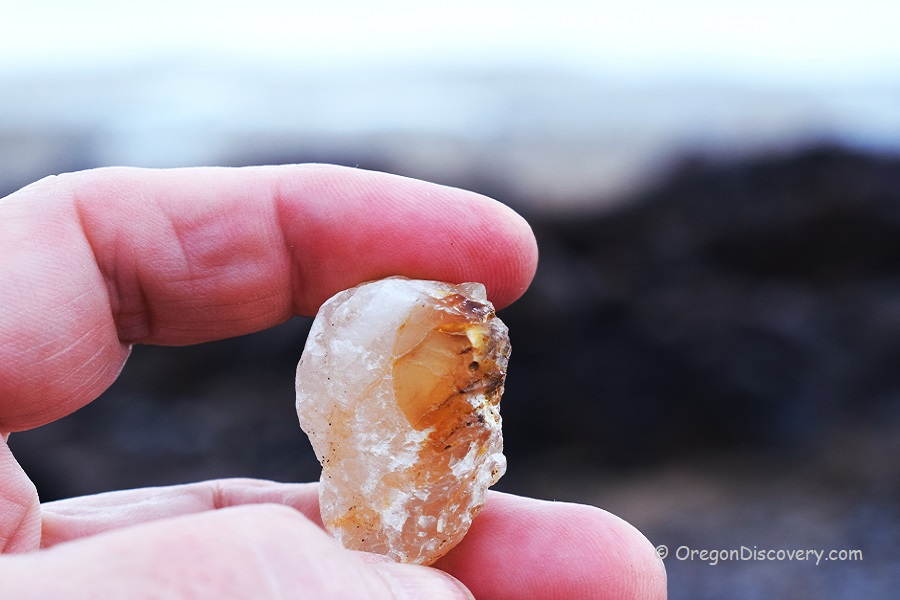

Sea Glass
Sea glass, often called 'mermaid tears,' is a blend of nature's artwork and human history. These smooth, frosted gems, once ordinary glass trash — bottles, jars, lenses, and even shipwreck remnants — undergo a remarkable transformation after years of tumbling in the ocean's waves, sand, and salt. Each piece of sea glass holds a secret story, a glimpse of the past. Its origins can be traced to shipwrecks, coastal communities, or seaside factories, making it a unique treasure of the sea.
Sea glass comes in a kaleidoscope of colors, ranging from translucent whites to deep blues, greens, and even rare reds.
You’re most likely to find sea glass on beaches near areas with higher human activity or historical sea traffic, where remnants of glass have had the chance to become these beautiful, naturally weathered gems.

Sand Dollars
A unique coastal treasure, the eccentric sand dollar is a flat species of sea urchin, commonly found on sandy sea floors, often in dense groups. These fascinating creatures come in a range of colors, from white and gray to brown, purple, or even deep black. Recently deceased sand dollars, which still retain their original color and outer coating, are less desirable for collectors because their flesh can quickly develop a rancid odor. For this reason, collectors are advised to look for white, sun-bleached sand dollar shells that are free of any remaining flesh.
Most sand dollar shells you find will be damaged by the surf, but occasionally, you may come across a whole, intact piece! Discovering an undamaged sand dollar is a cherished moment, with its pale, sun-bleached disc evoking images of pirate doubloons.
Sand dollars can be found all along the Oregon coastline, but certain beaches offer better chances of discovering these beautiful shells. Seaside Beach at the mouth of the Necanicum River is one of the best locations for sand dollar hunting. The coastline near the Nestucca River - including Kiwanda Beach, Bob Straub State Park, and Waconda Beach near Pacific City - also offers excellent opportunities. Other promising locations include Moolack Beach and Seal Rock Beach south of Newport, as well as the sandy shores near Florence, North Bend, and Bandon.
Glass Floats
Glass artists handcraft exquisite orbs for annual events at Lincoln City and Gold Beach, creating a treasure hunt for beachcombers.
Lincoln City hosts the Finders Keepers Glass Floats Event from mid-October to Memorial Day, where nearly 3,000 glass floats are hidden along seven miles of public beach. If you find a float, you can receive a certificate of authenticity. Some lucky finders may even win a special prize. During Antique Week, 300 Japanese glass floats are placed on the beach, and for Valentine’s Day, heart-shaped glass pieces are hidden.
Gold Beach’s Kissing Rock event is similar, transforming three miles of South Beach into a glass float hunting ground from February through April. If you find a tagged float, check in with the South Beach Visitor’s Center for a chance to win a prize.
Handcrafted treasures are often hidden in grassy areas or among driftwood above the surf line, but remember, you’re only allowed to keep one!

Metal Detecting
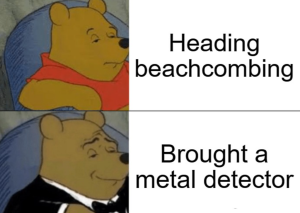 Beachcombing with a metal detector along the Oregon Coast can unearth (or unsand...is it even the word?) items with a unique story.
Beachcombing with a metal detector along the Oregon Coast can unearth (or unsand...is it even the word?) items with a unique story.
You might find modern (to pay for your metal detector) or vintage coins, perhaps something lost by an oceanside wanderer 100 years ago.
There's a fair shot at finding jewelry—rings, earrings, and even the necklace, lost by a modern or past beachgoer.
You can often encounter old fishing weights and boat fittings as a remnant of Oregon's rich maritime culture, lost to time and tides. Or something brought by the waters from the other place.
And if the metal detector beeps with a particularly enthusiastic tone, it could very well be historical relics like pieces from shipwrecks or artifacts left by early explorers or indigenous tribes.
Each find, from the mundane pull-tab to the silver dollar, is a page in the history of humanity in the Pacific. So, keep swinging that detector because you never know when the next beep might be your ticket to an untold story.
Boring Legal Stuff
Using a metal detector is legal without a permit in many spots on the ocean shore and at state parks. However, it is always a good idea to double-check the legalities of your specific area of choice. I don't want Officer Friendly to fine you.
Check the current rules and regulations on the Oregon State Parks website.
Tidepool Watching
While searching for treasures on the beach, take a moment to enjoy the living wonders of Oregon’s tidepools. These natural aquariums are filled with intertidal creatures like starfish, anemones, urchins, and crabs. While it’s tempting to collect ocean life, please refrain from disturbing the delicate ecosystem. Instead, take in the beauty of these marine marvels as you explore the rocky shorelines.

Best Times To Beachcomb
The best times for beachcombing on the Oregon coast revolve around the seasonal shifts and tidal patterns that wash ashore various oceanic gifts and remove the mass of sand and gravel, revealing the previously hidden treasure.
Winter and early spring after stormy weather are the best times since the powerful waves make hidden treasures surface.
Low tides, especially extreme low tides that occur a few times a year, reveal the hidden beach areas. Check the tide tables for those events.
Early morning is also an ideal time to find treasure since items freshly deposited overnight are undisturbed.

Be aware of various coastal dangers more frequent during these times, including sneaker waves.
For more effective and fun beachcombing, check my guide on the best tools to pack with you.
Oregon Coast Beaches & Landmarks
North Coast
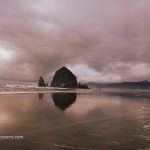 The breathtaking North Oregon Coast is about 100 miles long extending from the mouth of the Columbia River in Astoria to the Pacific City. Despite such a relatively short stretch of the coast, the variety of landscapes here is truly remarkable. You can see massive dunes, dense old-growth forests, expansive sandy beaches, towering sea stacks, broad gravel bars, and weathered basalt cliffs.
The breathtaking North Oregon Coast is about 100 miles long extending from the mouth of the Columbia River in Astoria to the Pacific City. Despite such a relatively short stretch of the coast, the variety of landscapes here is truly remarkable. You can see massive dunes, dense old-growth forests, expansive sandy beaches, towering sea stacks, broad gravel bars, and weathered basalt cliffs.
Central Coast
 Stretching for about 100 miles from Lincoln City to Florence and Winchester Bay, the Central Oregon Coast beaches combine incredibly diverse scenery and landscapes. 2rom basalt outcropping, tree-top cliffs, and colossal sea stacks to flat sand areas, extensive dunes, and broad gravel bars -- you can see them all here in Oregon!
Stretching for about 100 miles from Lincoln City to Florence and Winchester Bay, the Central Oregon Coast beaches combine incredibly diverse scenery and landscapes. 2rom basalt outcropping, tree-top cliffs, and colossal sea stacks to flat sand areas, extensive dunes, and broad gravel bars -- you can see them all here in Oregon!
South Coast
 The beaches of the South Oregon Coast stretch from North Bend and Coos Bay all the way down to the California border. The South Oregon Coast is an amazing destination, full of natural beauty, breathtaking shorelines, picturesque hiking trails, and a variety of places to visit that will, no doubt, make your trip memorable.
The beaches of the South Oregon Coast stretch from North Bend and Coos Bay all the way down to the California border. The South Oregon Coast is an amazing destination, full of natural beauty, breathtaking shorelines, picturesque hiking trails, and a variety of places to visit that will, no doubt, make your trip memorable.
Safety Tips
- Before you go for beachcombing, check tides
- Never turn your back to the ocean, the ocean conditions can change quickly
- Watch for sneaker waves
- Have your beach access available
- Avoid logs and debris
- Avoid slick rocks and stay away from cliff edges.
You May Also Like
Attention, Fellow Beachgoers!
Unfortunately, our beautiful Pacific Northwest beaches are stained with trash, especially plastic. We at Oregon Discovery, as well as other unaffiliated groups of nature lovers, made a commitment to do our part in keeping our beaches clean, but we need your help too!
Whenever you go out to enjoy nature at your favorite spot, please bring a trash bag or two and help us pick up garbage. Even picking up a little bit here and there will make a huge long-term difference.
Please help us save our beautiful nature for generations to come!

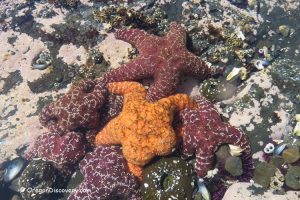

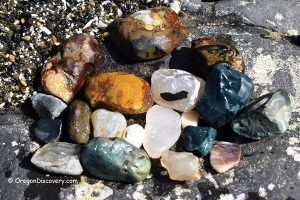
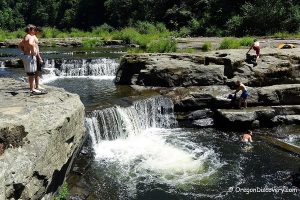
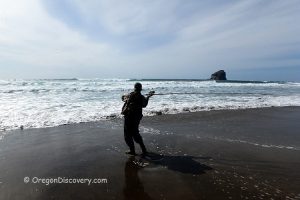
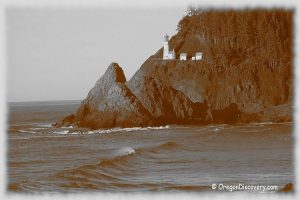
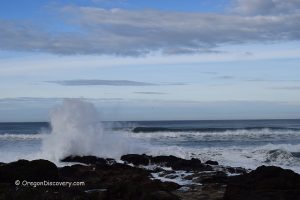

It doesn’t even say jade
Awesome! Thanks for the great outline! Taking my kids on a hunt after the next storm!
Yes, we do have coastal jade. I’m on the southern oregon coast. I found a piece of jade last week, on the beach. I have a picture that’s backlit and it’s magnificent.
We absolutely *DO* have nephrite pieces on the southern Oregon beaches. Especially around the mouth of the Rogue. What’s really surprising is that there aren’t apparently economic-sized deposits in the Klamath mountains of Oregon — surprising, because the geology is quite favorable.
Also, after collecting every single little agate-type stone you can find — even the tiny ones, *especially* the tiny ones — make sure to have a real close look at all of them before you toss any back on the beach. Save any with evident crystal faces for further examination, because they just, might, *possibly* be diamonds (yes, there are diamond deposits in the Klamath mountains — somewhere, possibly lamprophyre intrusions, or just weathering out of the upper-mantle section of ophiolites. These are subduction zone diamonds, which aren’t super well understood).
The southern Oregon beaches also have very fine gold and platinum group deposits in the black sands.
So I recently visited Oregon’s beaches between Bandon and Florence . Among the petrified wood , agates , fossils and shells was a plain white flat rock . Upon closer inspection at home I noticed it had glassy orange veins . I cut back the edges and WOW ! A beautiful piece of amber hidden inside . There’s a few identical pictures of rough amber online to reference. My dilemma is that I can’t find anything about Amber found in Oregon , and are the photos I’m comparing to actually another stone ?
So its either Quartz, Agate or Chalcedony, and the “amber” inside is Carnelian. They can range in color from yellow, orange, to red. They can dominate the whole mineral, so its glowing or have swirls inside or a combination of both.
Very hard to tell without seeing a picture, but in my experience that sounds like what you have there. Good find!